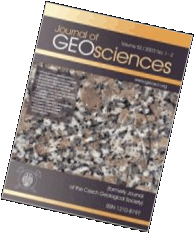 Export to Mendeley
Export to Mendeleyhydrogen bonding
clinoclase
gilmarite
density functional theory
structural complexity
metastability
Original Paper
Hydrogen bonding and structural complexity of the Cu3(AsO4)(OH)3 polymorphs (clinoclase, gilmarite): a theoretical study
Journal of Geosciences, volume 62 (2017), issue 2, 79 - 85
DOI: http://doi.org/10.3190/jgeosci.231
Density functional theory (DFT) is used to determine positions of H atoms and to investigate hydrogen bonding in the crystal structures of two polymorphs of Cu3(AsO4)(OH)3: clinoclase and gilmarite. Hydrogen bonds in clinoclase involve interactions between hydroxyl groups and O atoms of arsenate tetrahedra, whereas the crystal structure of gilmarite features OH…OH bonding, which is rather uncommon in copper hydroxy-oxysalts. Information-based parameters of structural complexity for clinoclase and gilmarite show that the former is more complex (IG,total = 213.212 bits/cell) than the latter (IG,total = 53.303 bits/cell), which indirectly points out that gilmarite is metastable. This suggestion is supported by the lower density of gilmarite (4.264 g/cm3) compared to that of clinoclase (4.397 g/cm3). The hypothesis of metastable character of gilmarite is in agreement with the Goldsmith’s simplexity principle and the Ostwald-Volmer rule.
Webdesign inspired by aTeo. Hosted at the server of the Institute of Petrology and Structural Geology, Charles University, Prague.
ISSN: 1803-1943 (online), 1802-6222 (print)
email: jgeosci(at)jgeosci.org


IF (WoS, 2024): 1.3
5 YEAR IF (WoS, 2024): 1.4
Policy: Open Access
ISSN: 1802-6222
E-ISSN: 1803-1943